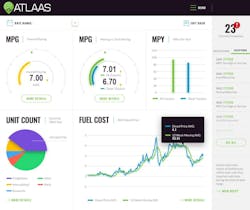This is Part Two of a Two-Part story. Read Part One here.
Artificial intelligence has the potential to change how people work in many different industries, and commercial vehicle repair is no exception. In Part One of this story, we discussed how AI can help technicians streamline repairs by identifying the root cause of an issue from a similar instance in a shop's records, or assist in filtering parts and inventory data or Vehicle Maintenance Reporting (VMRS) Standard codes.
But shop managers can also put AI to work in the back office as well, granting their organic intelligence more room for problem solving and big-picture processes beyond the day-to-day minutae of running a shop.
Inorganic human resources
Recruiting new technicians has always been a time-consuming endeavor. It gets even harder when there’s a shortage of talent. A company called Whiterail Recruits is finding that a balance of human and artificial intelligence can work in tandem to help solve this problem. It can also make a maintenance manager’s life a lot easier.
“A good diesel technician is gold these days,” said David Ostrov, head of operations at Whiterail Recruits, a marketing services company that leverages a unique advertising algorithm and generative AI to more efficiently recruit drivers and technicians. “You need to know how to talk to technicians to really court them.”
This is where Whiterail’s experience in digital advertising comes into play. Their human talent creates compelling, highly targeted, smartphone-friendly ads for websites, social media, and apps that the typical diesel technician tends to use. But even here, Whiterail’s human talent will often use various AI tools to ask for advice on what the ad should say and to create imagery.
AI starts playing a bigger role when a person clicks on one of those ads. The person is sent to an AI-driven, chat-based hiring platform on a Whiterail recruitment webpage. This is where the automation kicks in.
“You really need someone who is on task with this,” said Daniel Ostrov, head of marketing at Whiterail. “They need to be responding to text messages all day, every day, within minutes. It’s just not feasible for most diesel repair shops, so we’ve built an AI tool into our recruiting platform that communicates with candidates instantaneously and even schedules them for appointments.”
First, Whiterail’s AI chatbot asks some prequalifying questions like years of experience, certifications, if they can pass a background check, etc. “The candidate is literally hitting buttons on their phone to answer the questions,” David said. “They don’t need to do any typing. They don’t need a resume. They’re done in 40 seconds.”
The communication piece is as important as the convenience factor.
“You have to show some authenticity and relate to a technician, not come off as some kind of bureaucratic recruiter,” Daniel said. That’s why the Whiterail AI team spent a lot of time training its chatbot on how to converse in a more casual, engaging way. In the early stages, the chatbot’s responses were too formal. “We had to spend a lot of time telling it what not to do,” David said.
Whiterail’s AI tool really makes an impact on efficiency once that prequalifying process is complete. It integrates with a variety of common calendar apps to automatically schedule a phone interview. The AI chatbot asks the candidate if they are available during certain timeframes. Once some timeframes are confirmed, the AI scans the calendar of the maintenance manager or other individual who’ll be conducting the phone interview to automatically select a time. The chatbot also asks the candidate for their email address and mobile number so appointment reminders can automatically be sent in the lead-up to the interview.
Read more: How to unleash the power of predictive maintenance
Thus far, Whiterail’s AI-driven process has shown some success. According to David, one of the companies that has utilized the system, Champion FleetCare, hired three qualified diesel technicians in 30 days. More importantly, the AI-driven process helped generate 25 applicants, 12 of whom were qualified and 11 of whom showed up for the phone interview. And the maintenance manager spent considerably less time chasing down those applicants because AI did a lot of the tedious work for him.
The need for more data and trust
In addition to automation, AI’s biggest strength is its ability to analyze data and quickly provide insights. In that respect, could a fleet maintenance team already be in a pretty good spot with the technologies they are already using? After all, some software platforms already do an excellent job of retrieving and presenting vital information in easy-to-use dashboards and reports.
“A maintenance manager typically has 500 things to do a day, but only has time for 400,” said Brian Antonellis, senior vice president of fleet operations at Fleet Advantage. “It’s beneficial to be able to go into one dashboard through one portal and quickly determine the four or five items they need to act on right away, as they can with our ATLAAS platform.”
Fleet Advantage provides asset management services to some of the largest fleets in the industry. They leverage the knowledge and intuition of their team of industry experts to analyze multiple streams of vehicle data, allowing them to devise a plan to help a fleet achieve the lowest TCO for each vehicle. It’s an extremely data-driven process—which seems perfect for generative AI.
“Could AI do all of that kind of analysis for us? It’s a good question,” Antonellis said. “We are certainly not going to lean away from it. We are going to lean into AI, make sure we understand it, and figure out what it could do for us and our customers.
“Maybe 10 or 15 years from now, we’ll be able to get AI into a system specifically built where all of this predictive modeling is done,” he continued. “But we want to make sure we don’t go too fast. We’re protective of our customers’ information, and we want to make sure the analytics we’re making are the right ones.”
The reality is that the pace and volume of data isn’t slowing down. In many respects, it’s already too much for a human being to handle.
“As more information flows into an ecosystem like ours, we must continue searching for ways to leverage it to the benefit of our customers,” Decisiv’s Pittinger said. “We have to remember, AI technology is still in a nascent state. Everyone is hyping it to death, but it’s not to the point where the typical fleet maintenance manager will be actively using it. It’s really up to companies like ours to incorporate AI into our existing technology set so we can deliver even more value to fleets and dealers.”
Even though the technology is new, all shop leaders should start to familiarize themselves with how using AI as a digital “right-hand man” can give them a leg up, especially those who heavily rely on data coming into the shop.
“Maintenance managers who are already looking at reports and dashboards of their telematics data will benefit from the speed of information AI can provide,” added Mike Branch, VP of data and analytics at Geotab.
And for those who’ve felt a little overwhelmed by the onslaught of data coming at them, AI can make it easier to get at the precise information they’re looking for. Any leader knows you don’t always need to know the answer; you just need to know who can get it. And in more and more cases, this will be the on-call data scientist waiting on your smart device or office computer.
With so much emphasis on helping drive vehicle uptime, AI could be just the tool to provide managers with the downtime from the day-to-day grind to use their own human intelligence, for which there still is no substitute, to help improve the shop.
About the Author

Gregg Wartgow
Gregg Wartgow is a freelancer who Fleet Maintenance has relied upon for many years, writing about virtually any trucking topic. He lives in Brodhead, Wisconsin.


